M.J. Johnson's Blog, page 5
June 23, 2015
Book Promo for N & H and Roadrage
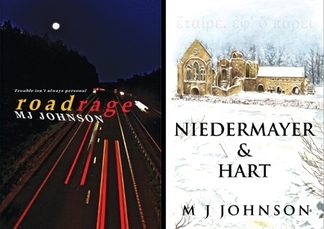 A long-lost but recently rediscovered second cousin of mine living in Cardiff, who is an accomplished graphic designer/illustrator, kindly emailed me a few weeks back to say that he thought I had some work to do on my website. “It’s all about branding!” he advised. I took his advice, scratched my head for a bit and set to work. I haven’t been in communication with aforementioned cousin since putting these website changes into place and hope he finds them an improvement. I certainly think the site looks a good deal better for a make-over and brush-up. I’ll let those who visit it be the judge of that!
A long-lost but recently rediscovered second cousin of mine living in Cardiff, who is an accomplished graphic designer/illustrator, kindly emailed me a few weeks back to say that he thought I had some work to do on my website. “It’s all about branding!” he advised. I took his advice, scratched my head for a bit and set to work. I haven’t been in communication with aforementioned cousin since putting these website changes into place and hope he finds them an improvement. I certainly think the site looks a good deal better for a make-over and brush-up. I’ll let those who visit it be the judge of that!Having reworked my website I thought I ought to do a book promotion to get the whole thing nicely launched. That is why for the next week, starting on Wednesday 24 June at 8 am British time and at 8 am PST for US readers, both Niedermayer & Hart and Roadrage will be available on Kindle Countdown deals.
At Amazon UK Niedermayer & Hart and Roadrage will remain at 99p from 8 am 24 June until 8 am 30 June when they revert back to their listed price of £1.99.
On Amazon.com Niedermayer & Hart and Roadrage will both start at $0.99 on 24 June at 8 am, and increase to $1.99 on 27 June before finally reverting back to their list prices on 30 June of $2.99.
This is almost certainly the last time these books will be available on a countdown deal as I intend to withdraw them for sale exclusively on Kindle and broaden their sales outlets, which will make them ineligible for this particular promotion. They will, of course, still be available on Kindle but only at the list price!
These people found the books quite by chance:
“I found Niedermayer & Hart through Twitter recommendations and am really glad to have done so. In many ways a classic horror story, the tale incorporates the twists and turns of a contemporary crime thriller and the combination makes for a breathtaking read.” - review left for Niedermayer & Hart on Amazon
“Brilliant, gripping and a real page turner. Couldn't put this book down, so many twists and turns you just have to keep on reading. Downloaded this last year when it was on Countdown Deals, so glad I did. Can thoroughly recommend you will not be disappointed. Will definitely read more from this author.” - review for Roadrage posted on Amazon
Happy reading!

N & H at Amazon.UK
N & H at Amazon.com

Roadrage at Amazon.UK
Roadrage at Amazon.com
Published on June 23, 2015 10:47
June 13, 2015
Context
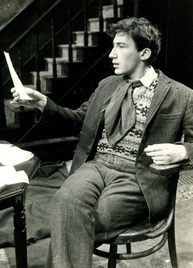 Donal Davoren, Shadow of a Gunman by Sean O'Casey, RADA, 1976 I’ve seen a number of theatrical productions recently in which the play’s time period has been studiously ignored. Frankly, I don’t get the reasoning behind this. Is it to make the play more accessible to a modern audience? If so, then I think it’s a pretty flimsy argument. Of course, for many decades we’ve had Shakespearean productions that have taken the play and placed it into an updated time-frame (not necessarily modern day). I recall as a teenager seeing a hugely entertaining ‘hippie’ version of As You Like It at the RSC in Stratford directed by Buzz Goodbody which I found quite staggering. I’ve seen countless Shakespearean productions since that weren’t in either Elizabethan or Jacobean dress and haven’t been bothered by it at all. It makes very little difference whether Hamlet is performed in its original setting or any other that may take the director’s fancy. The language and references contained in the text are forever reminding us of when the play was written; and whether the Montagues and Capulets battle in the dark alleyways of Verona or amongst the dingy tenements of Brooklyn it makes very little difference, just so long as we get a sense of the play’s context.
Donal Davoren, Shadow of a Gunman by Sean O'Casey, RADA, 1976 I’ve seen a number of theatrical productions recently in which the play’s time period has been studiously ignored. Frankly, I don’t get the reasoning behind this. Is it to make the play more accessible to a modern audience? If so, then I think it’s a pretty flimsy argument. Of course, for many decades we’ve had Shakespearean productions that have taken the play and placed it into an updated time-frame (not necessarily modern day). I recall as a teenager seeing a hugely entertaining ‘hippie’ version of As You Like It at the RSC in Stratford directed by Buzz Goodbody which I found quite staggering. I’ve seen countless Shakespearean productions since that weren’t in either Elizabethan or Jacobean dress and haven’t been bothered by it at all. It makes very little difference whether Hamlet is performed in its original setting or any other that may take the director’s fancy. The language and references contained in the text are forever reminding us of when the play was written; and whether the Montagues and Capulets battle in the dark alleyways of Verona or amongst the dingy tenements of Brooklyn it makes very little difference, just so long as we get a sense of the play’s context.However, when I see a production of a more recent play, specific period seems far more significant. For instance, I recently saw the highly-acclaimed production of View from the Bridge by Arthur Miller. It was a well-acted production, presented to us in a style and setting reminiscent of Greek tragedy; the clothes were modern however, and for me, ignoring the play’s setting seemed to be going against what Miller was saying. The play is set in a tenement house in Brooklyn in the 1950s where Eddie Carbone, his wife Beatrice and her daughter Catherine live. Eddie is a longshoreman and a great deal has been written about the corrupt unions and use of cheap illegal immigrant labour. For me (and for everyone currently living), this is a modern period, everyone must know someone alive at that time which immediately connects them to that time-frame. I must say I begin to wonder where I am when Sicilian peasants come on stage in modern dress, talk in perfect American accents (although they have just arrived illegally) and speak of the terrible poverty they have escaped from back home. This is not a context that helps me understand the play or makes it more accessible; as far as I’m concerned it’s just pointless and confusing. Likewise when Eddie Carbone tells his adopted daughter that her dress is too short, I guess Miller had in mind something just above the knee, but in this production the line had a whole different connotation because Catherine appeared on stage wearing something resembling a ra-ra skirt.
Similarly, I also recently saw a modern dress production of A Streetcar Named Desire by Tennessee Williams. This play is set in the late 1940s in New Orleans’ French Quarter, and without its sense of time and place the characters lose their significance. Stanley Kowalski becomes nothing more than a mindless thug unless we understand his thin skin about being the son of dirt-poor Polish immigrants to America. When Stella, a sympathetic character, tells Stanley that Blanche’s late husband was ‘a deviant’ - meaning he was simply ‘gay’ - it seems totally implausible coming from the mouth of a young woman in modern clothing. Likewise, the personality of Blanche DuBois seems totally anachronistic within a modern setting - and it begins to feel like the DuBois family home in Laurel, Mississippi must be a planet in a galaxy, far-far-away.
I could go on! Why was Man and Superman by George Bernard Shaw, a play written in the Edwardian era, recently staged at the National Theatre in modern dress? I’m sorry, but I find it hard to believe the characters’ shock and horror at a young woman’s pregnancy when their maid (maid?) is walking around in a pair of jeans!
Don’t get me wrong. I enjoyed all these productions, but I honestly believe I would have enjoyed them even more had they done the ‘boring’ thing and simply been true to the play’s period. The two most affecting pieces of live theatre I’ve seen in recent years were Ghosts by Henrik Ibsen and The Crucible by Arthur Miller - both these productions were presented within their correct time-frame and I came away from the auditorium after seeing them emotionally wrung-out. I’ve heard a couple of directors recently comment that younger audiences wouldn’t find older plays relevant unless they had been reinvented in a contemporary setting. I honestly believe that they are in danger of underestimating the intelligence of young theatre-goers.
Published on June 13, 2015 06:28
June 7, 2015
Brainy Stuff!
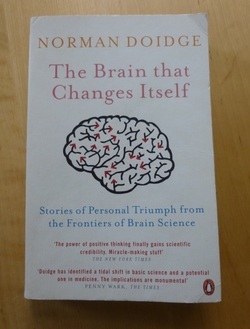 I’ve recently read The Brain That Changes Itself by Norman Doidge, which is about the cutting-edge science of ‘neuroplasticity’ and the ability of the brain to rewire itself. I’m not a natural target for books on science subjects - there isn’t a shelf of books anywhere in my house labelled ‘brain books’! So far, I’ve always been (and probably always will be!) an eclectic reader; for instance, I’ve now finished with brains and moved on ( yee hah!) to The Giant Book of the Western. I suppose I’ll read anything that satisfies my current mood and fulfills its own remit ie I wouldn’t expect a Jo Nesbo crime thriller to be a meditation on the human being’s place in the universe - I’d re-read Hermann Hesse if I fancied a bit of that.
I’ve recently read The Brain That Changes Itself by Norman Doidge, which is about the cutting-edge science of ‘neuroplasticity’ and the ability of the brain to rewire itself. I’m not a natural target for books on science subjects - there isn’t a shelf of books anywhere in my house labelled ‘brain books’! So far, I’ve always been (and probably always will be!) an eclectic reader; for instance, I’ve now finished with brains and moved on ( yee hah!) to The Giant Book of the Western. I suppose I’ll read anything that satisfies my current mood and fulfills its own remit ie I wouldn’t expect a Jo Nesbo crime thriller to be a meditation on the human being’s place in the universe - I’d re-read Hermann Hesse if I fancied a bit of that. I actually came across this book after my ninety-one year old mother-in-law read it in a couple of sittings and described it as ‘fascinating’. It was given her to read by my wife Judith who found it in a charity shop and seems to possess an unerring eye for choosing the right book for the right person. I often go to her when nothing on my TBR pile appeals and I’m not sure which book to pick up next. It’s a bit like consulting a ‘book oracle’; believe me the woman has uncanny powers when it comes to books and I never doubt her infallibility to cast her eye into her crystal ball, tea leaves, entrails or whatever - “What is it you seek, O gentle reader?”- and then select the right book (please don’t tell her I mentioned she has strange arcane powers - I’ve always worried about being turned into a frog).
Anyway, The Brain That Changes Itself is a psychology/science book that is easily approached by any layman like myself. It is written in bite-sized segments and I certainly found it an enjoyable and fascinating read. The basic premise of the book is that the brain is ‘plastic’ rather than (as scientists believed for many generations) irrevocably hard-wired. Doidge presents us with a number of jaw-dropping case histories to back up his theories and the book has quite a large ‘wow’ factor. I read with great fascination how an academic after suffering a most devastating stroke which destoyed a large part of his brain, leaving him with very little speech and partly paralysed, was able to make a complete recovery by ‘rewiring’ his brain, literally by-passing the damaged part. Or how the girl born with only a right hemisphere to her brain had been able to seemingly do the impossible and operate fairly normally.
These are inspiring stories, yet I can’t help feeling there’s something missing here. I’m not accusing Norman Doidge MD of being a snake-oil salesman, however, this book often reminded me of one of those best-selling self-help books that has you cheering but ultimately leaves you feeling a little unconvinced and dissatisfied. Just like the writers of self-help books are apt to do, the author here relies mostly on individual case-histories and he gives very few scientifically backed up facts or statistics. The section on psychoanalysis again makes the kinds of leaps and jumps that might be acceptable in a pacy thriller but I kept asking myself ‘Hang on just a minute there! Just because Mr X lost his mum at the age of three and has always had problems showing his wife affection, this all seems a little bit too much like a tit-bit style magazine when a psychiatrist comes along and puts two and two together, after which the patient has a few significant dreams and in the final scene Mr X goes off happily restored, a devoted family man again.’
In the early part of the book a number of neuroplasticity experiments are dispassionately quoted, and I have to say, when monkeys had nerves in their hands or arms severed and probes inserted into their brains, or kittens were deliberately blinded by sewing up an eyelid, I did feel a little queasy. I found the section on addiction, particularly the part on sex addiction, sado-masochism etc really quite shocking too. However, I’m not entirely sure whether the startling conclusions the author comes to in support of neuroplasticity are always quite as clear-cut as the author would have me believe. I think what I’m saying (as someone who is a completely non-scientific person) that I’m really not certain this book is good science. The Brain That Changes Itself is an enjoyable read and I’m sure there is much more to learn about neuroplasticity, but I’m not sure I can fully endorse all the claims put forward in this book.
I’m currently really enjoying my book of Western short stories (personally recommended by the ‘book oracle’). And as for brains, Steve Martin’s The Man with Two Brains literally made me fall off the sofa laughing when I first watched it on TV!
Published on June 07, 2015 04:32
May 31, 2015
Scaredy Cat!
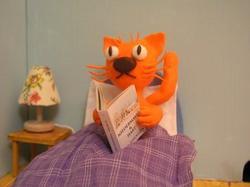 I remember back in 1977 watching The Towering Inferno at a cinema in Derby. It was while I was doing my very first acting job, a national tour for a Theatre in Education company. Because we performed in schools and therefore worked daytimes, my evenings were always free, so I’d taken the opportunity to catch this popular star-studded disaster movie. In those days, long films tended to have an intermission, and this one I recall came to its half-way point leaving Paul Newman and Steve McQueen on an explosive cliff-hanger; after a number of well-loved box-office names had already been char-grilled, deep-fried, toasted and flambéed to the delight of the audience. In those days people still smoked in public places, and as the light on the silver screen faded at the half-way mark and before the house-lights came on to guide us to our Kia-Ora and choc ices, the chap next to me struck a match to light his cigarette. Still entirely caught-up in the movie, I saw the naked flame in my peripheral vision and literally jumped about a foot in the air!
I remember back in 1977 watching The Towering Inferno at a cinema in Derby. It was while I was doing my very first acting job, a national tour for a Theatre in Education company. Because we performed in schools and therefore worked daytimes, my evenings were always free, so I’d taken the opportunity to catch this popular star-studded disaster movie. In those days, long films tended to have an intermission, and this one I recall came to its half-way point leaving Paul Newman and Steve McQueen on an explosive cliff-hanger; after a number of well-loved box-office names had already been char-grilled, deep-fried, toasted and flambéed to the delight of the audience. In those days people still smoked in public places, and as the light on the silver screen faded at the half-way mark and before the house-lights came on to guide us to our Kia-Ora and choc ices, the chap next to me struck a match to light his cigarette. Still entirely caught-up in the movie, I saw the naked flame in my peripheral vision and literally jumped about a foot in the air!Embarrassing.
I suppose that reading is generally a good deal safer than film-going . The stuff I write isn’t likely to cause any similar embarrassment - not publicly anyway! Although if you’re planning to read Niedermayer & Hart at bedtime you might heed the following warning posted on Goodreads:
“... If I use the quality of my nightmares as a rating system for horror novels, this one was definitely a 5/5 ... Just don't read this book right before you go to sleep unless you like waking up in the middle of the night in a cold sweat with your own screams echoing in your ears.”
This could prove awkward if sharing a room!
Niedermayer & Hart from Amazon.com
Niedermayer & Hart from Amazon.co.uk
Published on May 31, 2015 08:48
May 25, 2015
We Are Many
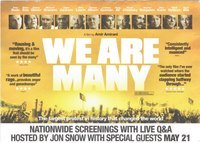 We rarely make visits to the cinema to watch documentaries, we tend to catch up with these on the small screen. However, we made an exception for We Are Many, a film by Amir Amirani, a respected London-based journalist/film-maker of Iranian origin. His film, which has received very little publicity, is about the protest marches that took place right around the world on 15 February 2003 in opposition to the furious scramble for war being driven by the government of George W Bush in the US and heavily supported by our British Government led by Tony Blair.
We rarely make visits to the cinema to watch documentaries, we tend to catch up with these on the small screen. However, we made an exception for We Are Many, a film by Amir Amirani, a respected London-based journalist/film-maker of Iranian origin. His film, which has received very little publicity, is about the protest marches that took place right around the world on 15 February 2003 in opposition to the furious scramble for war being driven by the government of George W Bush in the US and heavily supported by our British Government led by Tony Blair.The London protest, which we took part in, was reputed to have been somewhere between 1.5 and 2 million people strong - the official figure halved this figure of course! However, I have no difficulty believing that we were nearer the number quoted by the march organisers. We came out of Charing Cross Station on the morning of 15 February and immediately found ourselves amongst people we knew from the Sussex village where we’d formerly lived for ten years. We shuffled off along the Strand with them, then went down to and along the Embankment taking us through Westminster, and along a route through central London that eventually brought us to Hyde Park. Our progress was at a snail’s pace, and it took more than five hours to reach our destination. The march in London was only one among roughly eight hundred similar protests taking place in cities right around the world on that day and it has been estimated that something in the region of 30 million people mobilised themselves. What was remarkable about the London march was the sheer diversity of the people who took part in it, people from literally every walk of life and background. I remember feeling incensed by the rush to go to war, with Hans Blix and the UN weapons inspectors pleading for just a few more weeks to prove conclusively that the Weapons of Mass Destruction for which they were searching did not exist.
On the day of the March I remember thinking to myself how it was inconceivable that a British Labour Government could ignore the voices of so many raised in peaceful protest. How wrong I was! The true civilian death toll from the Iraq War has never been published; the number is estimated to be somewhere between 500,000 and 1 million. The cost of the Iraq War was about £10 billion to UK taxpayers and somewhere in the region of $2.2 trillion dollars to US taxpayers. All the coalition forces lost far too many of their sons and daughters there - for a cause that has since been shown to be totally erroneous. The Middle East is certainly not a safer place for this intervention and the toppling of the indisputably wicked Saddam Hussein and his foul regime has not made life in Iraq better, in fact it has been shown that simply containing him would have led to far far fewer deaths. It has always struck me as a very bad joke that Tony Blair, shortly after he stood down as UK Prime Minister, was appointed Middle Eastern Peace Envoy working on behalf of the US, Russia, the UN and the EU.
This film is anything but sensationalist, however it is truly disturbing. It doesn’t have any big financial backing so distribution is patchy, but I hope you’ll find a venue and get a chance to watch We Are Many . I highly recommend seeing it.
Published on May 25, 2015 08:23
April 25, 2015
Bring Me Sunshine!
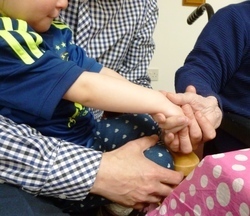 The sun has taken its hat off and has been shining down on us for well over a week now, a situation I find very tolerable, although I’m suffering a little earlier than is normal for me with hay fever symptoms. I suspect the pollen situation must be high this year as even Judith was violently sneezing a few days back and said she thought she was coming down with a cold - no cold developed but she’s still sneezing a lot! I guess that’s what happens when acres and acres of Kent countryside are turned over to oil-seed rape. You know, I really could launch a personal vendetta against that particular genus of plant!
The sun has taken its hat off and has been shining down on us for well over a week now, a situation I find very tolerable, although I’m suffering a little earlier than is normal for me with hay fever symptoms. I suspect the pollen situation must be high this year as even Judith was violently sneezing a few days back and said she thought she was coming down with a cold - no cold developed but she’s still sneezing a lot! I guess that’s what happens when acres and acres of Kent countryside are turned over to oil-seed rape. You know, I really could launch a personal vendetta against that particular genus of plant!The last week or so has been fairly uneventful. We went to a jolly good organic farm shop the other day and we plan to stop shopping in supermarkets quite so much and lend our support to these people who are doing a good job at a fair price and making the world a bit greener and healthier in the process! I daresay I’ll be writing more on this blog about Cherry Gardens Organic Farm Shop in the future.
The second draft of the follow-on book to Niedermayer & Hart is busy underway at the moment and I’m really enjoying it. Mrs J gets given the completed chapters and really doesn’t have a clue what it’s about yet; of course she recognises themes, characters etc from N & H - but says she trusts that I’ll bring the whole thing together satisfyingly by the end (poor deluded fool!). I hadn’t previously discussed anything about the book with her, she didn’t see a word of the first draft, and so she’s experiencing it now completely ‘blind’ as it were. I personally find this is a really good opportunity for gauging response - and so far, so good! I stopped writing for over a week while we had some guests staying from Amsterdam, and although I was happy to get back to work, I didn’t in any way resent stopping work for our lovely relatives. It was fun spending time with them and we especially enjoyed having a toddler about the place, Tee hee hee! Actually they were model house guests. Judith’s Mum is the little-un’s Great-Great-Grandmother - now that has to be a pretty rare five-generations photo opportunity!
Keep smiling whether the sun is shining or not - might as well!
Published on April 25, 2015 02:23
April 9, 2015
Easter Mondays!
 Dad was very proud of his Austin The sun made a sudden and unexpected appearance at a happy family occasion held on Saturday last and I’m delighted to say has remained present over the ensuing days. It seems like years since sunny weather might be anticipated at Easter time in the UK with any kind of reasonable expectation. However, when I was a boy/teenager in the sixties and seventies, unless memory misleads, the British Isles seems to have enjoyed far more agreeable weather.
Dad was very proud of his Austin The sun made a sudden and unexpected appearance at a happy family occasion held on Saturday last and I’m delighted to say has remained present over the ensuing days. It seems like years since sunny weather might be anticipated at Easter time in the UK with any kind of reasonable expectation. However, when I was a boy/teenager in the sixties and seventies, unless memory misleads, the British Isles seems to have enjoyed far more agreeable weather.The Johnson family acquired its first car, an Austin A30, around 1964. We were one of the first families on our road in Gowerton, near Swansea, to own a car and my father would have been forty-two by the time he set about learning to drive. In those times if you left the car parked on the road you had to leave its side-lights on, which played havoc with car batteries. I remember Dad was forever charging it and topping its cells up with distilled water. Mam never learnt to drive and always cited the skill as one of her most regretted non-accomplishments. In conversations with her right to the end of her life she (an Aries!) maintained she would almost certainly have made a very good driver. She most definitely made a damn fine driving instructor - as my father often experienced, “You went round that bend a bit fast, Danny!”
Most of the time Dad remained stoically good-tempered with his ever-present advisor alongside; but very occasionally he’d snap, “Do you drive, Mair?”
She would respond dismissively, as though this small fact was simply an irrelevance, “No.”
“Well shut up then and let me get on with it!”
A tense hush sometimes descended upon the front of the car at these times. In such difficult moments, awkward looks were exchanged in the back seat between me and my friend Keith, who was almost guaranteed to be present if we were on an outing to the seaside.
At Easter we invariably headed for the coast, regardless of the weather. If wet, we browsed our way slowly through the town’s Woolworths, hoping climatic conditions might soon alter for the better. Perhaps this was the reason why I felt so genuinely sad when these stores finally closed down a few years back - they were such a powerful icon from my childhood. However, if the sun was shining we’d be on the beach with our buckets and spades, and when Mam told us, teeth chattering, tinged blue and shivering from head to toe, to get out of the sea after an hour’s joyous splashing, we’d always insist we weren’t cold at all. She’d generally have to bribe us in some little way to get us to come peacefully, thereby probably saving us from being hospitalised with hypothermia. If we went to Porthcawl we’d have faggots and peas (this is a meatball akin to haggis and not to be confused with the North American definition for a faggot) in the fair for our lunch, or, Mam’s heavily salted cucumber sandwiches with a chunk of cheese, always ingested with large quantities of sand. There was generally an ice cream or two to be had on an Easter Bank Holiday Monday and if the destination was Porthcawl (Mam’s lifelong Mecca) it could only be a Fulgoni’s cone. Last thing, as the sun was going down and everyone started heading for home there was always a bag of fish and chips, scalding hot, served up in newspaper, always smothered in salt and dripping with vinegar, to be eaten as we made our way back to the car. Lovely.
Published on April 09, 2015 11:04
March 21, 2015
Behind the Beautiful Forevers
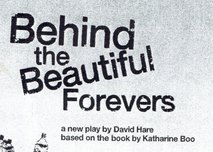 It has been a little while since our last outing to watch a play under the NT Live banner, and it’s probably true to say that a theatre piece set in the slums of Mumbai didn’t immediately get me racing for a seat - the clincher was probably the fact it had been dramatised by David Hare. His play, Behind the Beautiful Forevers, is based on American Pulitzer Prize-winner Katherine Boo’s non-fiction work of the same title. Katherine Boo, married to a man with Indian citizenship, spent three years gaining the trust of the people whose lives she sought to record for her book.
It has been a little while since our last outing to watch a play under the NT Live banner, and it’s probably true to say that a theatre piece set in the slums of Mumbai didn’t immediately get me racing for a seat - the clincher was probably the fact it had been dramatised by David Hare. His play, Behind the Beautiful Forevers, is based on American Pulitzer Prize-winner Katherine Boo’s non-fiction work of the same title. Katherine Boo, married to a man with Indian citizenship, spent three years gaining the trust of the people whose lives she sought to record for her book.She focused on the men, women and children who are forced to live by their wits in Annawadi, a makeshift slum area close to Mumbai airport and its adjacent luxury hotels . It has a large sewage lake lying just beside it, and when you look at photographs of the place it’s hard to believe how the structures, so far from any concept of vertical, can ever stay upright. The people here collect the rubbish discarded by those who live in the other Mumbai with its billionaires and global ambitions. I can’t speak for the book because I haven’t read it, although it is now most certainly on my To Read list.
The play reminded me of the kind of work we were regularly presented with on British TV in the 60s and 70s through slots like Play for Today. Thank God for NT Live and subsidised theatre, because how else could such a large-scale production be possible? TV it seems to me has largely given up its remit of educating its audience in this way. David Hare’s writing is seamless, as was Rufus Norris’s direction - there were times when I actually forgot I was watching a piece of theatre; the set design lighting and production were all top-notch as was the ensemble playing of an excellent British Asian cast. It was unremittingly dark at moments as it depicted the desperate lives of these men, women and children who exist by their wits in this often truly grim place.
As we left the Odeon Tunbridge Wells and drove home in our nice car to our comfortable home we still felt shocked and perhaps a little bit ashamed that such places as Annawadi exist in this world that we are all supposed to share - well, we are, aren’t we?
Definitely worth seeing if you get a chance. There is another NTLive transmission on 2 April, and the last performance of the play is at the National Theatre on 5 May.
Published on March 21, 2015 10:24
March 13, 2015
Buddy Reading 'Strangers on a Train' by Patricia Highsmith
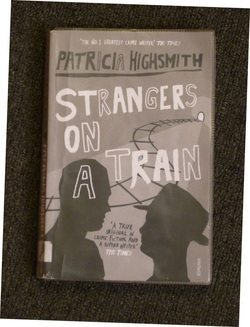 I read four out of the five Ripley novels by Patricia Highsmith a few weeks back - I drew the line at Ripley Under Water because the reviews by many of her die-hard fans were far from celebratory about it and I hadn’t enjoyed The Boy Who Followed Ripley (the penultimate Ripley book) at all. The Ripley series is undoubtedly patchy. From what I’ve read about her, Patricia Highsmith had a serious problem with alcohol, which is so often the the cause of decline or degeneration in the work of many great artists. Make no mistake, Patricia Highsmith, when on top of her game, is second to none as a writer of the psychological novel. I say novel rather than thriller because I think it rather underestimates the quality of Highsmith’s best work to describe it as mere thriller writing - not that there’s anything wrong with a darn good thriller. The two best titles in the Ripley series (almost universally agreed by all it seems) are The Talented Mr Ripley and Ripley’s Game, the former I’d describe as a psychological novel, the second I’d describe as an effective psychological thriller.
I read four out of the five Ripley novels by Patricia Highsmith a few weeks back - I drew the line at Ripley Under Water because the reviews by many of her die-hard fans were far from celebratory about it and I hadn’t enjoyed The Boy Who Followed Ripley (the penultimate Ripley book) at all. The Ripley series is undoubtedly patchy. From what I’ve read about her, Patricia Highsmith had a serious problem with alcohol, which is so often the the cause of decline or degeneration in the work of many great artists. Make no mistake, Patricia Highsmith, when on top of her game, is second to none as a writer of the psychological novel. I say novel rather than thriller because I think it rather underestimates the quality of Highsmith’s best work to describe it as mere thriller writing - not that there’s anything wrong with a darn good thriller. The two best titles in the Ripley series (almost universally agreed by all it seems) are The Talented Mr Ripley and Ripley’s Game, the former I’d describe as a psychological novel, the second I’d describe as an effective psychological thriller.I discuss books quite a lot, on Goodreads, Twitter, Facebook or sometimes on this blog - I guess they’re a way of life. My old Biology teacher from school (nicknamed ‘Charlie Biol’ a little unimaginatively) used to like to lecture us boys on the merits of reading, “Boys, if you have a good book, then you’re never without a friend!” He was absolutely right of course, and all my life I’ve kept my ‘friends’ close by. I mentioned reading the Ripley books to someone on Twitter, a self-confessed book addict, who said she’d enjoyed The Talented Mr Ripley but hadn’t got on with any of the others. However, she did express an interest in reading Strangers on a Train - Highsmith’s first novel. I proposed a ‘Buddy Read’. This is something I don’t normally have time for, not because I don’t enjoy them, but simply because I always have an alarming TBR pile. My wife decided to join us, so on 1 March (St David’s Day) we three arrived at Highsmith station and set off on our journey together!
What an astounding first novel! This book is sixty-five years old but remains to this day a considerably shocking edge of the seat read. And I don’t mean that it contains graphic violence or gripping action sequences - not at all. This book is a psychological novel that gets deep under the skin of its two main characters. We plough straight into the story from page one; we’re suddenly there, in the train compartment where our strangers meet. Believe me, what ensues is increasingly tense and quite unnerving. The compulsive way this novel is written makes the reader feel like they too are trapped, just like the book’s main protagonist Guy Haines, in an unceasing nightmare. As trains are driven along an irrevocably permanent track, we its readers, often squirming with anticipation, observe two increasingly desperate men reach their inevitable destinations. As in The Talented Mr Ripley, Strangers on a Train has a strongly understated homo-erotic element lurking just underneath the story’s surface. I’m assuming this would have made the book unpublishable in 1950 if it had been more overtly stated. If you like exceedingly well-written, utterly compulsive and rather disturbing psychological novels/thrillers, then I can highly recommend this one.
My ‘Buddy Read’ pals and I are now thinking about our next outing - it’ll probably be in the Autumn. The only criteria: a book previously unread by all; a book we all fancy reading! Just let me know if you’d like to join in!
Published on March 13, 2015 15:49
March 4, 2015
A Trip to Wales and Another Good Welshman
 The wife and I spent the weekend in Wales - most appropriate of course, to be back home for St David’s Day! We stayed with a newly reacquainted long-lost relative in Cardiff. One of my first engagements as a professional actor was for a theatre company, long defunct, based in Cardiff, called the Welsh Drama Company. I enjoyed working in the city then and have continued to do so whenever work or play have taken me back there. It has continued to improve as a city. When I worked there initially the magnificent St David’s Hall was simply a building site and the whole shopping area around it was in the process of being redeveloped. A great deal of Cardiff was rather grey, just as much of post-industrialised Britain looked back then. Its heyday as a port, at one time one of the world’s largest exporters of coal, was past, and this once economically vigorous city was struggling to find a new role for itself in the world. Of course Cardiff has seen many more great building projects since the late Seventies, including the redevelopment of the whole Bay Area which includes the Welsh Assembly Building and the Millenium Centre. And of course our national passion (bordering on obsession) for the game of rugby is now catered for at the magnificent Millenium Stadium, right in the heart of the city.
The wife and I spent the weekend in Wales - most appropriate of course, to be back home for St David’s Day! We stayed with a newly reacquainted long-lost relative in Cardiff. One of my first engagements as a professional actor was for a theatre company, long defunct, based in Cardiff, called the Welsh Drama Company. I enjoyed working in the city then and have continued to do so whenever work or play have taken me back there. It has continued to improve as a city. When I worked there initially the magnificent St David’s Hall was simply a building site and the whole shopping area around it was in the process of being redeveloped. A great deal of Cardiff was rather grey, just as much of post-industrialised Britain looked back then. Its heyday as a port, at one time one of the world’s largest exporters of coal, was past, and this once economically vigorous city was struggling to find a new role for itself in the world. Of course Cardiff has seen many more great building projects since the late Seventies, including the redevelopment of the whole Bay Area which includes the Welsh Assembly Building and the Millenium Centre. And of course our national passion (bordering on obsession) for the game of rugby is now catered for at the magnificent Millenium Stadium, right in the heart of the city.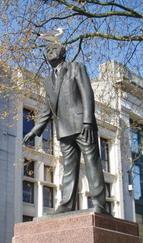 Any visitor entering Cardiff’s Queen Street from the Castle end is met by the statue of Aneurin Bevan (1897 - 1960), or Nye as he’s more affectionately remembered in Wales. He was born and raised in the valleys town of Tredegar, the son of a coal miner. He left school to work in the pits himself at the age of thirteen, where he soon became active in the trade union movement, which sent him to Central Labour College in London. It was here that he gained in confidence as a speaker and began to overcome the stammer that he had been afflicted with since childhood. In 1929 he stood and became elected as the Labour MP for Ebbw Vale, and he was to remain in this seat for the next thirty-one years until his early death. He is perhaps best remembered for his achievement as the architect of the National Health Service, which became fully operational on the 5 July 1948. He defined a civilised society as one that takes care of its weak and vulnerable. Those of us who have grown up in a happy time where health care was provided unquestioningly by the state have Nye Bevan to thank for this. The National Health Service wasn’t born without suffering the pangs of childbirth and was vehemently opposed by the Conservative Party, the British Medical Association and by some in Bevan’s own Labour Party.
Any visitor entering Cardiff’s Queen Street from the Castle end is met by the statue of Aneurin Bevan (1897 - 1960), or Nye as he’s more affectionately remembered in Wales. He was born and raised in the valleys town of Tredegar, the son of a coal miner. He left school to work in the pits himself at the age of thirteen, where he soon became active in the trade union movement, which sent him to Central Labour College in London. It was here that he gained in confidence as a speaker and began to overcome the stammer that he had been afflicted with since childhood. In 1929 he stood and became elected as the Labour MP for Ebbw Vale, and he was to remain in this seat for the next thirty-one years until his early death. He is perhaps best remembered for his achievement as the architect of the National Health Service, which became fully operational on the 5 July 1948. He defined a civilised society as one that takes care of its weak and vulnerable. Those of us who have grown up in a happy time where health care was provided unquestioningly by the state have Nye Bevan to thank for this. The National Health Service wasn’t born without suffering the pangs of childbirth and was vehemently opposed by the Conservative Party, the British Medical Association and by some in Bevan’s own Labour Party.The National Health Service is, we are currently told by too many of its workers to be just scare-mongering, splitting at its seams. It is one of the finest institutions this country has, and we would all be far poorer for its loss. I for one will almost certainly be considering it as one of the foremost issues to be considered when the time comes for me to cast my vote in the general election in May. My Great Aunt Mary had lived almost sixty years before the National Health Service and the Welfare State were fully in place for the protection of all British citizens. I was often amused as a young boy when she expressed her darkest fear of ending up in the workhouse - it seemed preposterous to me then; workhouses belonged to the world of Oliver Twist and Charles Dickens! Actually, the workhouse system was only abolished in 1930. But the kind of poverty experienced by the working classes of the past isn’t possible today, is it? Again, I am reminded of Food Banks and the 900,000 British people forced to resort to them last year.
In 2004 Aneurin Bevan was voted No 1 by the people of Wales in a poll to name 100 great Welsh men and women. After my recent visit to Wales, and seeing as it’s customary for this blog to present to its readers a Good Welshman or Welshwoman on St David’s Day - I give you Nye Bevan: “The National Health service and the Welfare State have come to be used as interchangeable terms, and in the mouths of some people as terms of reproach. Why this is so it is not difficult to understand, if you view everything from the angle of a strictly individualistic competitive society. A free health service is pure Socialism and as such it is opposed to the hedonism of capitalist society.”
Published on March 04, 2015 07:38



